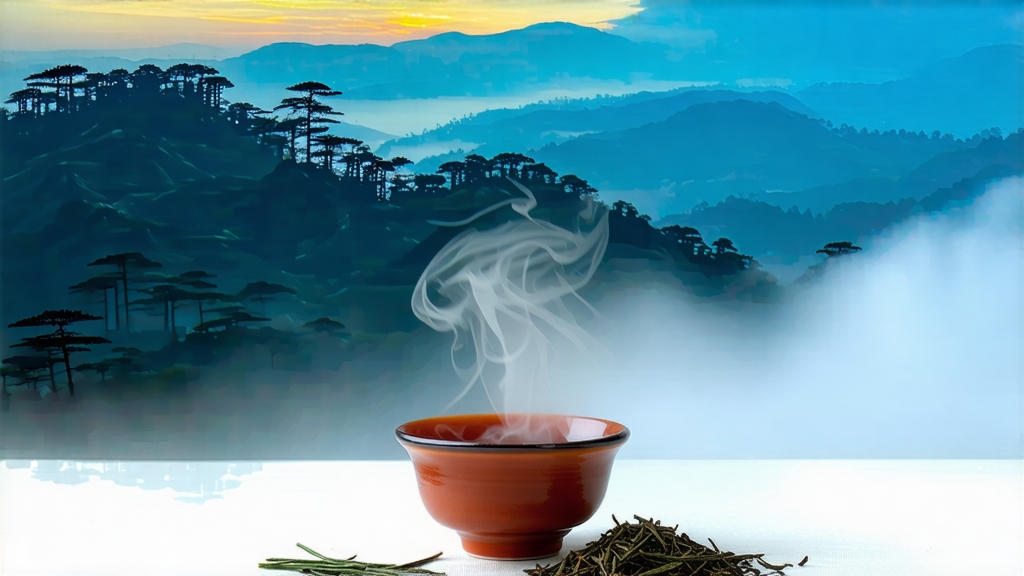
When European tea lovers first spoke of “black tea” in the seventeenth century, the leaves they held were almost certainly Lapsang Souchong. Grown in the granite gorges of the Wuyi massif in Fujian province, this pioneering red tea (hong cha) set the template for every malty Assam, every bright Ceylon, every brisk Kenyan that would later wash across the globe. Yet its own story is still anchored in a single mist-locked nature reserve where pine, bamboo and camellia sinensis share the same mineral soil.
History: From Mountain Refuge to London Drawing Room
Legend dates the birth of Lapsang Souchong to 1646, when Qing troops pressed into the Wuyi highlands. Local tea farmers, eager to dry their harvest before fleeing, rushed the withering leaves over open pine fires. The accidental smoke infusion proved sensational; Dutch and British traders at the port of Xiamen paid premium prices for the “smoky bohea,” and by 1669 the East India Company listed it as one of its first three commodities from China. The name itself encodes provenance: “souchong” refers to the fourth and fifth leaves down the stem—larger, tougher foliage that tolerates heavy withering and smoking, while “lapsang” is the romanisation of the village name Zheng Shan, literally “Original Mountain.” Thus every authentic leaf must originate within the 60 km² core of the Wuyi National Nature Reserve, an UNESCO mixed heritage site whose basalt cliffs and subtropical forest create the cool, humid microclimate that softens tannin and amplifies aroma.
Cultivar & Harvest: Two Leaves, One Bud Rewritten
Although any Wuyi tea bush can theoretically yield souchong, two clonal cultivars dominate today. The traditional Wuyi Cai Cha (mixed seed stock) gives a complex, resinous cup but modest yield. Since 1985 the research station in Fujian has promoted Zheng Shan Xiao Zhong, a selected bush with slightly downy leaves, faster spring re-growth and higher polyphenol oxidase activity—perfect for the heavy oxidation that follows smoking. Plucking begins each year around Qingming festival: two mature leaves and the accompanying bud are snapped at the node, ideally before 10 a.m. while dew still lingers. Experienced pickers look for a subtle purple edge on the leaf margin, an indicator of elevated anthocyanins that will translate into burgundy-coloured liquor.
Craft: Smoke as Signature, Not Mask
The making of Lapsang Souchong is a six-act drama performed within 24 hours.
- Outdoor withering: trays of leaves rest on bamboo racks set in shaded courtyards. Ambient mountain breezes reduce moisture to 68 % while initiating grassy-to-fruit enzymatic change.
- Indoor withering: leaves are moved to the upper floor of a three-storey wooden house where the temperature is kept at 28 °C. Hand-tossing every 20 minutes bruises the edges, accelerating oxidation.
- Rolling: once the leaves emit a sweet raisin aroma, they are rolled under light pressure for 40 minutes, breaking cell walls and releasing juices that will later caramelise.
- Oxidation: rolled leaves are heaped in deep bamboo baskets lined with wet cloth. Humidity above 85 % and temperature around 25 °C coax the leaf from green to copper within three hours. Master sniffers hover over the baskets, waiting for the precise moment when green astringency vanishes and a baked apple note appears.
- Smoking: the decisive act. A pit is dug in the ground floor of the house and filled with resin-rich Masson pine roots that have aged at least three years. The wood is ignited, then smothered to smoulder at 80 °C. A perforated bamboo tray holding the oxidised leaves slides two metres above the embers; the smoke must be cool enough not to cook the leaf yet potent enough to permeate it. Every 15 minutes the tray is rotated, and fresh pine needles are tossed on the coals to release a burst of terpenic oils. Total smoking time ranges from six hours for “light smoke” export style to eighteen hours for the traditional Russian market grade.
- Drying & Sorting: final drying on charcoal racks drops moisture to 5 %. Leaves are then passed through a series of mesh screens; only the evenly twisted, jet-black strands qualify as Zheng Shan Xiao Zhong. Broken flakes become the